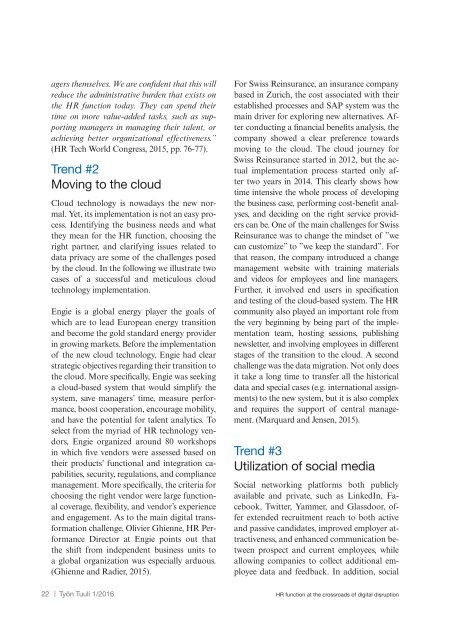Työn
TyonTuuli_012016_net
TyonTuuli_012016_net
You also want an ePaper? Increase the reach of your titles
YUMPU automatically turns print PDFs into web optimized ePapers that Google loves.
agers themselves. We are confident that this will<br />
reduce the administrative burden that exists on<br />
the HR function today. They can spend their<br />
time on more value-added tasks, such as supporting<br />
managers in managing their talent, or<br />
achieving better organizational effectiveness.”<br />
(HR Tech World Congress, 2015, pp. 76-77).<br />
Trend #2<br />
Moving to the cloud<br />
Cloud technology is nowadays the new normal.<br />
Yet, its implementation is not an easy process.<br />
Identifying the business needs and what<br />
they mean for the HR function, choosing the<br />
right partner, and clarifying issues related to<br />
data privacy are some of the challenges posed<br />
by the cloud. In the following we illustrate two<br />
cases of a successful and meticulous cloud<br />
technology implementation.<br />
Engie is a global energy player the goals of<br />
which are to lead European energy transition<br />
and become the gold standard energy provider<br />
in growing markets. Before the implementation<br />
of the new cloud technology, Engie had clear<br />
strategic objectives regarding their transition to<br />
the cloud. More specifically, Engie was seeking<br />
a cloud-based system that would simplify the<br />
system, save managers’ time, measure performance,<br />
boost cooperation, encourage mobility,<br />
and have the potential for talent analytics. To<br />
select from the myriad of HR technology vendors,<br />
Engie organized around 80 workshops<br />
in which five vendors were assessed based on<br />
their products’ functional and integration capabilities,<br />
security, regulations, and compliance<br />
management. More specifically, the criteria for<br />
choosing the right vendor were large functional<br />
coverage, flexibility, and vendor’s experience<br />
and engagement. As to the main digital transformation<br />
challenge, Olivier Ghienne, HR Performance<br />
Director at Engie points out that<br />
the shift from independent business units to<br />
a global organization was especially arduous.<br />
(Ghienne and Radier, 2015).<br />
For Swiss Reinsurance, an insurance company<br />
based in Zurich, the cost associated with their<br />
established processes and SAP system was the<br />
main driver for exploring new alternatives. After<br />
conducting a financial benefits analysis, the<br />
company showed a clear preference towards<br />
moving to the cloud. The cloud journey for<br />
Swiss Reinsurance started in 2012, but the actual<br />
implementation process started only after<br />
two years in 2014. This clearly shows how<br />
time intensive the whole process of developing<br />
the business case, performing cost-benefit analyses,<br />
and deciding on the right service providers<br />
can be. One of the main challenges for Swiss<br />
Reinsurance was to change the mindset of ”we<br />
can customize” to ”we keep the standard”. For<br />
that reason, the company introduced a change<br />
management website with training materials<br />
and videos for employees and line managers.<br />
Further, it involved end users in specification<br />
and testing of the cloud-based system. The HR<br />
community also played an important role from<br />
the very beginning by being part of the implementation<br />
team, hosting sessions, publishing<br />
newsletter, and involving employees in different<br />
stages of the transition to the cloud. A second<br />
challenge was the data migration. Not only does<br />
it take a long time to transfer all the historical<br />
data and special cases (e.g. international assignments)<br />
to the new system, but it is also complex<br />
and requires the support of central management.<br />
(Marquard and Jensen, 2015).<br />
Trend #3<br />
Utilization of social media<br />
Social networking platforms both publicly<br />
available and private, such as LinkedIn, Facebook,<br />
Twitter, Yammer, and Glassdoor, offer<br />
extended recruitment reach to both active<br />
and passive candidates, improved employer attractiveness,<br />
and enhanced communication between<br />
prospect and current employees, while<br />
allowing companies to collect additional employee<br />
data and feedback. In addition, social<br />
22 | <strong>Työn</strong> Tuuli 1/2016<br />
HR function at the crossroads of digital disruption


